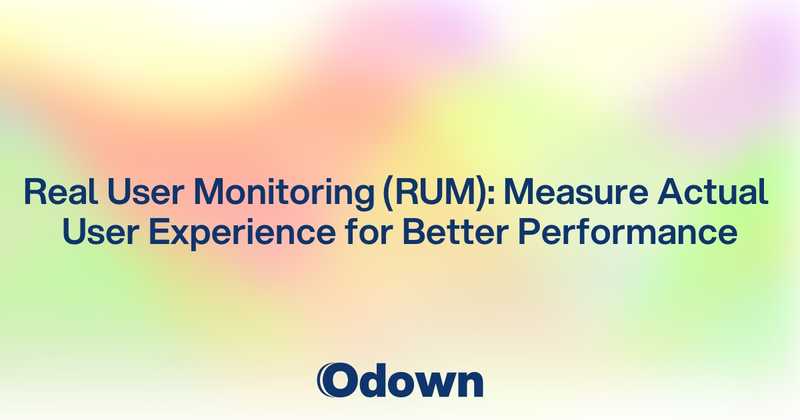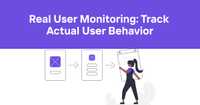Real User Monitoring (RUM): Measure Actual User Experience for Better Performance
Your Lighthouse score is 95. Your synthetic monitoring shows everything loading in under 2 seconds. Your load testing proves your servers can handle 10x current traffic. Yet users keep complaining about slow performance, and your conversion rates are mysteriously low.
Here's the problem: all your performance data comes from perfect testing conditions that don't match reality. Your users browse from old phones on spotty networks while running a dozen other apps. They access your site during peak hours when everything is congested. They experience the web completely differently than your testing tools do.
Real User Monitoring (RUM) bridges this gap by measuring actual user experience rather than simulated performance. Instead of guessing how your site performs in the real world, RUM shows you exactly what your users experience - the good, the bad, and the surprisingly ugly truth about performance in production environments.
RUM vs Synthetic Monitoring: When to Use Each Approach
Both RUM and synthetic monitoring have their place in comprehensive performance monitoring strategies, but they serve different purposes and reveal different insights about your application performance.
Synthetic Monitoring Strengths and Limitations
Synthetic monitoring excels at providing consistent, controlled measurements that help you understand performance trends and catch regressions during development. It runs from known locations with predictable network conditions, making it perfect for establishing performance baselines and monitoring specific user workflows.
The controlled nature of synthetic monitoring is also its biggest limitation. It can't capture the performance variations that real users experience due to device differences, network conditions, geographic distribution, and usage patterns that don't match your test scripts.
Synthetic monitoring works great for catching obvious performance problems and validating that basic functionality works correctly. It's less effective at revealing the subtle performance issues that only affect certain user segments or occur under specific real-world conditions.
Use synthetic monitoring for regression detection, SLA monitoring, and development workflow integration. It provides early warning when deployments break basic functionality or when infrastructure problems affect service availability.
Real User Monitoring Advantages
RUM captures performance data from actual user sessions, revealing the full spectrum of real-world performance characteristics. This includes slow mobile devices, congested networks, distant geographic locations, and complex user behavior patterns that synthetic tests can't replicate.
RUM data includes context that synthetic monitoring lacks: actual device capabilities, real network conditions, user location, browser versions, and behavioral patterns. This context helps you understand why performance varies and which factors have the biggest impact on user experience.
The volume and diversity of RUM data provides statistical power that synthetic monitoring can't match. Instead of a few test transactions per hour, you get performance data from thousands of real user sessions that reveal patterns and edge cases.
RUM also captures business context alongside performance metrics. You can correlate slow page loads with conversion rates, understand how performance affects user engagement, and identify which performance problems actually impact business outcomes.
Complementary Monitoring Strategies
The most effective performance monitoring strategies combine both RUM and synthetic monitoring to get comprehensive visibility. Synthetic monitoring provides consistent baseline measurements and early problem detection. RUM provides real-world validation and user experience insights.
Use synthetic monitoring for development workflows, alerting on major performance regressions, and monitoring critical user workflows from specific locations. Use RUM for understanding actual user experience, identifying performance optimization opportunities, and correlating performance with business metrics.
Synthetic monitoring helps you catch problems before they affect users. RUM helps you understand which problems actually matter to users and which performance improvements provide the most business value.
Implementing RUM: Technical Setup and Data Collection Strategies
Effective RUM implementation requires careful planning around data collection, privacy compliance, and performance impact of the monitoring itself.
Client-Side Data Collection
RUM implementations typically use JavaScript to collect performance data directly from user browsers. Modern browsers provide rich performance APIs that expose detailed timing information about page loading, resource fetching, and user interactions.
The Navigation Timing API provides comprehensive data about page load performance, including DNS lookup time, connection establishment, server response time, and various stages of document processing. This API works consistently across modern browsers and provides the foundation for most RUM implementations.
Resource Timing API captures performance data for individual resources like images, stylesheets, and scripts. This helps identify which specific assets contribute to slow page loads and optimization opportunities that might not be obvious from aggregate page timing data.
User Timing API allows you to add custom performance markers for application-specific events like API calls, user interactions, or business workflow completions. This extends RUM beyond basic page load metrics to capture business-relevant performance data.
Performance Data Collection Strategy
Focus your RUM data collection on metrics that correlate with user satisfaction and business outcomes rather than trying to capture every possible performance measurement. Too much data creates analysis paralysis and increases infrastructure costs without providing proportional insights.
Prioritize Core Web Vitals measurements since these correlate with user experience and affect search rankings. Largest Contentful Paint (LCP), First Input Delay (FID), and Cumulative Layout Shift (CLS) provide standardized metrics that you can benchmark against industry standards.
Collect business-relevant timing data for key user workflows like login processes, checkout flows, and content creation activities. These measurements help you understand how performance affects conversion rates and user engagement in your specific application.
Include environmental context with performance measurements: device type, network connection speed, geographic location, and browser capabilities. This context helps you understand performance variations and identify optimization opportunities for specific user segments.
Sampling and Data Management
RUM generates enormous amounts of data, especially for high-traffic websites. Implement intelligent sampling strategies that capture sufficient data for analysis without overwhelming your data infrastructure or creating privacy concerns.
Use stratified sampling that ensures you capture performance data across different user segments rather than just sampling randomly. You want representation from mobile and desktop users, different geographic regions, various browser types, and different network conditions.
Consider adaptive sampling that increases data collection when performance problems are detected and reduces collection during normal operation. This approach provides detailed data when you need it most while minimizing overhead during stable periods.
Implement data aggregation and retention policies that balance analysis needs with storage costs and privacy requirements. Raw RUM data typically needs short retention periods, while aggregated performance trends can be stored longer for historical analysis.
Technical Implementation Considerations
RUM monitoring should have minimal impact on the performance it's trying to measure. Use asynchronous data collection that doesn't block page rendering or user interactions. Lazy-load RUM scripts when possible to avoid affecting initial page load performance.
Implement error handling for RUM data collection to prevent monitoring failures from affecting user experience. RUM scripts should fail gracefully and never cause application errors that users can see.
Consider using service workers or background data transmission to minimize the performance impact of sending RUM data to your analytics infrastructure. Batch data transmission and use efficient serialization formats to reduce network overhead.
Plan for RUM data transmission failures due to network issues or ad blockers. Implement retry logic and offline data storage when appropriate, but don't let monitoring data accumulate indefinitely on client devices.
RUM Data Analysis: Extracting Actionable Insights from User Behavior
Raw RUM data requires sophisticated analysis to extract actionable insights that drive meaningful performance improvements.
Performance Distribution Analysis
Focus on performance distributions rather than just average metrics. Average response times hide the fact that some users experience dramatically different performance than others. Percentile analysis reveals how many users experience poor performance and how bad that performance actually is.
95th percentile response times often reveal performance problems that averages miss entirely. If your average page load time is 2 seconds but your 95th percentile is 10 seconds, 5% of your users are having terrible experiences that could drive them away from your site.
Analyze performance distributions across different user segments to identify optimization opportunities. Mobile users might have consistently worse performance than desktop users. Users from certain geographic regions might experience poor performance due to CDN configuration issues.
Look for bimodal or multimodal performance distributions that indicate your application performs very differently under different conditions. These patterns often reveal optimization opportunities that can dramatically improve user experience for specific scenarios.
Correlation Analysis with Business Metrics
Connect RUM performance data to business outcomes like conversion rates, user engagement, and customer satisfaction. This analysis helps you prioritize performance optimization work based on business impact rather than just technical metrics.
Track how page load performance affects conversion rates throughout your user workflows. E-commerce sites often see significant conversion rate improvements from relatively small performance optimizations, but the relationship varies by page type and user segment.
Analyze the relationship between performance and user engagement metrics like session duration, page views per session, and return visit rates. Poor performance often reduces user engagement in ways that compound over time.
Consider cohort analysis that tracks how performance affects user behavior over longer time periods. Users who experience poor initial performance might be less likely to return or engage deeply with your application even if later visits perform better.
Geographic and Device Performance Analysis
RUM data reveals performance variations across different user segments that can guide targeted optimization efforts. Geographic analysis helps identify CDN performance issues, server location problems, or regional network connectivity patterns.
Device-based analysis reveals how different hardware capabilities affect your application performance. Understanding the performance characteristics of popular mobile devices helps prioritize optimization work that affects the largest number of users.
Network analysis shows how different connection types affect performance and helps identify optimization opportunities for specific network conditions. Users on slower connections might benefit from different optimization strategies than users with fast broadband.
Browser analysis reveals compatibility issues and optimization opportunities specific to different browser engines. Performance characteristics often vary significantly between browsers, especially for newer web platform features.
Error Correlation and Impact Analysis
Correlate RUM performance data with application errors to understand how technical problems affect user experience. Some errors might have minimal user impact, while others could significantly degrade performance even when they don't prevent functionality completely.
Analyze the performance impact of different error types to prioritize bug fixes based on user experience impact rather than just error frequency. High-frequency errors with minimal performance impact might be less important than rare errors that cause significant slowdowns.
Track how performance degradation correlates with increased error rates to identify early warning signs of system problems. Performance degradation often precedes complete failures, making RUM data valuable for proactive incident response.
Privacy-Compliant RUM: GDPR and User Consent Considerations
RUM implementations must balance comprehensive data collection with privacy regulations and user consent requirements that vary by jurisdiction and user location.
GDPR Compliance Strategies
Under GDPR, RUM data collection often requires explicit user consent because performance monitoring involves processing personal data like IP addresses, browser fingerprints, and behavioral patterns. Design consent mechanisms that clearly explain what data you're collecting and why.
Implement data minimization principles that collect only the performance data necessary for your monitoring objectives. Avoid collecting personally identifiable information unless it's essential for your analysis, and anonymize or pseudonymize data whenever possible.
Provide clear mechanisms for users to withdraw consent and request data deletion in compliance with GDPR right to be forgotten requirements. This includes both stopping future data collection and removing previously collected data from your systems.
Document your legal basis for RUM data processing and ensure you can demonstrate compliance with GDPR requirements. Legitimate interest might apply for some RUM use cases, but explicit consent is often the safest approach for comprehensive performance monitoring.
User Consent Implementation
Design consent interfaces that clearly explain the benefits of performance monitoring without being overly technical or intimidating. Users are more likely to consent when they understand how performance monitoring helps improve their experience.
Implement granular consent options that allow users to opt into specific types of performance monitoring while declining others. Some users might be comfortable with basic performance metrics but not with detailed behavioral tracking.
Use consent management platforms that handle the complexity of different privacy regulations across multiple jurisdictions. These platforms can automatically adjust consent requirements based on user location and applicable laws.
Respect user consent choices consistently across all your performance monitoring implementations. Don't collect RUM data through alternative mechanisms when users have declined consent for your primary monitoring approach.
Data Anonymization and Aggregation
Implement data anonymization techniques that preserve the analytical value of RUM data while protecting individual user privacy. Hash IP addresses, remove or generalize identifying information, and use statistical techniques that prevent individual user identification.
Use data aggregation approaches that provide performance insights without storing individual user session data. Aggregated performance distributions, geographic summaries, and device category analysis often provide sufficient insights for optimization decisions.
Consider differential privacy techniques for RUM data analysis that add mathematical noise to prevent individual user identification while preserving overall data trends and patterns.
Implement data retention policies that automatically delete detailed RUM data after analysis periods while preserving aggregated insights for longer-term trend analysis.
Cross-Border Data Transfer Considerations
RUM implementations often involve transferring performance data across international borders for analysis and storage. Ensure compliance with data transfer regulations like GDPR adequacy decisions, Standard Contractual Clauses, or Binding Corporate Rules.
Use data processing agreements with RUM vendors that clearly define responsibilities for privacy compliance, data security, and cross-border transfer requirements. Understand where your RUM data is processed and stored geographically.
Consider data localization approaches that keep RUM data within specific geographic regions when required by local regulations or preferred by your users. Some RUM platforms provide region-specific data processing options.
Implement technical measures like encryption in transit and at rest that protect RUM data during international transfer and storage. These measures help demonstrate appropriate safeguards for cross-border data processing.
Real User Monitoring transforms performance optimization from guesswork into data-driven decision making. Instead of optimizing for theoretical performance improvements, you can focus on changes that measurably improve actual user experience and business outcomes.
The investment in comprehensive RUM implementation pays dividends in improved user satisfaction, better conversion rates, and more effective performance optimization efforts. You finally get to see your application through your users' eyes rather than just your testing tools' perspective.
Ready to implement Real User Monitoring? Odown provides comprehensive performance monitoring that combines RUM insights with uptime tracking and error monitoring. Combined with our error budget management strategies, you'll have the complete visibility needed to balance user experience optimization with reliability engineering practices that support sustainable development velocity.



